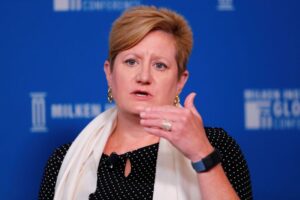Insights from Davos: Future of Interest Rates and Investment Strategies
At the recent World Economic Forum in Davos, Guggenheim Partners’ Chief Investment Officer, Anne Walsh, shared some intriguing insights regarding the U.S. Federal Reserve’s interest rate trajectory. With predictions for 2025 suggesting a quarterly reduction of approximately 75 basis points, or potentially a full percentage point throughout the year, investors must remain vigilant as they strategize for the coming months.
Slower Pace of Rate Cuts Ahead
Walsh highlighted that while the Fed will indeed be cutting rates, the pace may be slower than previously anticipated. This marks a shift in trader sentiment, with expectations moving from three cuts down to just one this year. Understanding this landscape will be crucial for investors keen on navigating the interest rate environment effectively.
It’s essential to consider how these adjustments will impact different asset classes. For instance, if the Fed reduces rates steadily, we could see a favorable environment for equities, especially sectors sensitive to borrowing costs, such as real estate and consumer discretionary.
The Tariff Landscape and Market Behavior
In her remarks, Walsh addressed potential tariffs that might come from the incoming administration. She suggested that these tariffs won’t be as draconian as some expect, particularly if the U.S. dollar maintains its status as the global reserve currency and continues attracting foreign capital. The forecast? Tariffs may rise by less than 10% on average and likely vary by country.
Investors should monitor how these tariffs could affect supply chains and manufacturing costs, presenting both challenges and opportunities in various sectors. Those focused on sectors like manufacturing and import-heavy businesses will need to remain agile in their strategies.
Bond Market Dynamics
After an impressive bull run that defined the bond market until 2022, it’s now settled into a trading range for the third consecutive year. Walsh noted the volatility within this range could present unique opportunities. If the 10-year yield approaches 5%, she views that as an extreme oversold position, indicating a buying opportunity for savvy fixed-income investors.
With tight bond yield spreads, the scenario suggests a favorable outlook for U.S. equities as well, provided investors accurately assess credit conditions.
Positive Trends in Equities
Looking ahead, Walsh expressed optimism regarding equities, forecasting the S&P 500 could yield returns between 8% to 10% by the end of 2025. The driving forces behind this anticipated growth include advancements in artificial intelligence, a resurgence in energy sectors, and the re-shoring of manufacturing back to the U.S.
As an investor, identifying and positioning within these future-forward sectors could yield significant benefits. Our previous articles have discussed how embracing technology-focused companies and those that prioritize domestic manufacturing can provide an edge in your investment strategy.
Navigating Political Uncertainty
However, it’s critical to remain aware of the uncertainties surrounding incoming political policies. Walsh compared the current situation to a game of ping pong, indicating that the interplay between politics and policy will likely create volatility throughout the year. This is a vital factor for investors to account for in their risk assessments and portfolio strategies.
As you refine your investment approach, consider how political changes can shift market dynamics rapidly. Diversification across asset classes, sectors, and geographies may mitigate risks stemming from this unpredictability.
The insights from Walsh at Davos offer substantial value to investors looking to navigate an evolving financial landscape. By adapting your strategies to accommodate this shifting environment, you can position yourself favorably for the years ahead. Stay tuned to Extreme Investor Network for more insights and strategies to optimize your investment journey.

